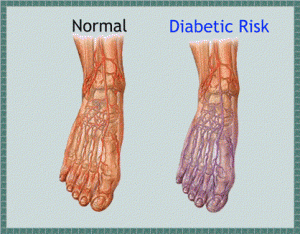 Diabetic foot pain symptoms and treatment are explained lucidly for your benefit. If you have diabetes, chances are you are also suffering from diabetic foot pain. This condition could be horrendously painful that is why it is important to know what the factors are that contribute to its occurrence and what you can do to prevent and treat it.
Diabetic foot pain symptoms and treatment are explained lucidly for your benefit. If you have diabetes, chances are you are also suffering from diabetic foot pain. This condition could be horrendously painful that is why it is important to know what the factors are that contribute to its occurrence and what you can do to prevent and treat it.
Diabetes and diabetic foot pain
When the body cannot regulate the blood sugar level, this will lead to high glucose (sugar) concentration in the blood. This condition is known as diabetes. Many complications could arise from having diabetes. For one, diabetics often suffer foot pain. In fact, there are four types of problems associated with diabetic foot pain.
• Peripheral Neuropathy
This is a nerve problem that causes diabetic foot pain. Sensory neuropathy is characterized by a burning, stabbing or tingling pain. Check your blood glucose level to see if there is a trend of high sugar levels for the past weeks. Persistent high glucose is a factor for this type of pain.
Foot pain could also be due to motor neuropathy wherein the muscles feel weak and painful. This condition manifests walking imbalance that may lead to constant abrasion of foot with the shoe, skin swelling, development of callous and pain.
Autonomic neuropathy, on the other hand, is affecting nerves on areas that we do not control consciously. The patient may experience excessive sweating or no sweating at all, resulting to dry skin that may crack or blister causing more pain.
• Poor circulation
Diabetes could hinder an individual’s normal blood circulation due to the narrowing of arteries. When the right amount of oxygen and nutrition are not brought to the tissues and skin of the legs and feet, this will impair the healing process. It is therefore critical for diabetics to take care of their feet as poor healing due to poor circulation could cause serious diabetic foot pain and other complications.
• Joint and muscle problems
These problems cause recurring pain and discomfort to diabetics. These lead to walking imbalance that makes the foot and joints move and position themselves in unnatural ways resulting to bunions, hammertoes, small cracks and dislocation of bones. Diabetic foot pain, ulceration, infection and other problems may then ensue.
• Chronic infections
Diabetics are prone to fungal and bacterial infections because of changes in their diet and medications. These cause inflammations, irritations, redness, blisters, accumulation of pus and foot pain. There are diabetics that cannot feel pain; hence, it is vital that the feet are checked every day for any signs of infection or other problems.
Diabetic Foot Pain Relief and Treatment
Basic proper foot care could greatly help prevent the onset of diabetic foot pain and other foot problems. The following are some simple ways you can prevent diabetic foot problems.
1. Control your diabetes. Live a healthy lifestyle to maintain your glucose near normal level. Work with your physician to make and stick to a diabetes plan.
2. Daily inspection of feet. Check for any abnormalities or problems such as swelling, red spots, ulcers, cuts, fungal infection and others. Should you find any, consult your doctor especially if it does not disappear after a day.
3. Clean your feet daily. Using warm water, wash your feet everyday. Remember not to immerse your feet in water for too long as this will result to dry skin. Make sure to dry your feet thoroughly, including the areas between the toes. Talcum powder could be applied to the feet and between the toes to keep them dry.
4. Moisturize your feet. By applying lotion to your feet, you will keep them smooth and soft. Rub lotion on the bottom and top of feet but not between toes as this might lead to infection.
5. Always wear socks and shoes. Going barefoot could easily harm your feet as you may step on something that could hurt you and your feet. Opt for seamless stockings, socks and nylons to prevent blisters and sores. Choose socks that are made of materials that absorb wetness and sweat away from your skin. Prior to wearing your shoes, make sure that there are no foreign materials inside that may cause pain to or hurt your foot. And of course, wear good-fitting footwear.
6. Keep your feet at the right temperature. Do not expose your feet to extremely hot or cold conditions. Use socks and proper foot gear at all times.
7. Keep proper blood circulation on your feet. Do not sit nor stand, nor cross your legs for long periods of time. Do not wear anything that could cut off the blood flow to your feet. Do not smoke as this reduces blood flow to feet.
8. Be active. Work with your doctor for the appropriate exercise regime for you. But remember to avoid high impact activities that are hard on the feet such as jumping.
9. Talk to your doctor. Have your doctor check your feet at least once per year. Consult your doctor for any concerns you may have regarding your diabetes.
Diabetic foot pain is just one of the many complications of diabetes. By following the aforementioned tips, you can prevent the onset of this condition.